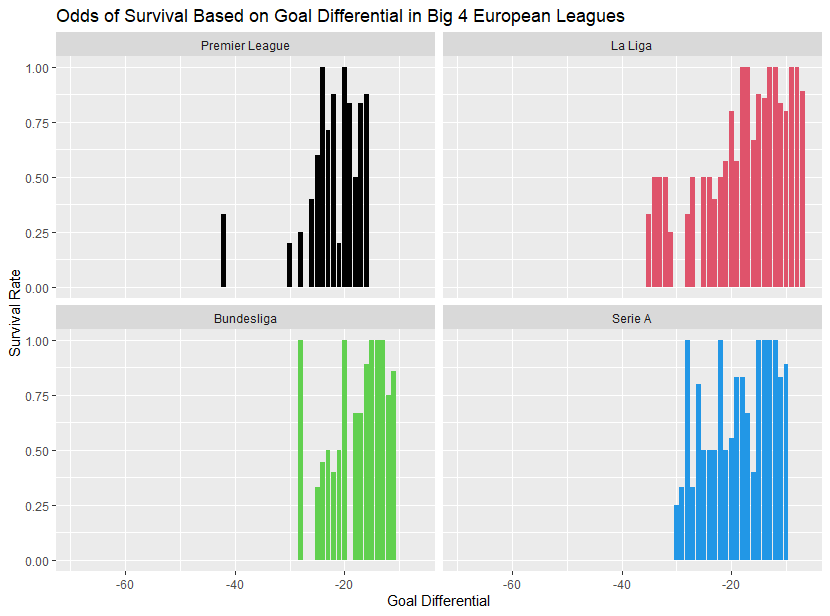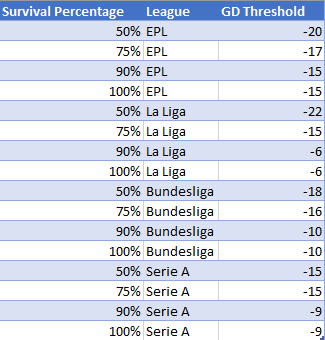European football is one of the most complex sports, but results come down to two simple concepts: scoring goals and preventing other teams from scoring. However, as the legendary Ballon d’Or winner and Barcelona manager Johan Cruyff once said,
soccer is simple, but it is difficult to play simple.
Every season in every league has teams score fewer goals than they allow, and in most cases, many fewer goals scored than allowed. The goal differential tracks this difference by subtracting goals allowed from goals scored. However, how good (or bad) must a team’s goal differential be to survive in the Big 4 European leagues (English Premier League, La Liga, Serie A, Bundesliga)?
Design
In this study, data was acquired from every team in the Big 4 leagues from the 2003/04 season to the 2019/20 season. Each team’s goal differential was tracked, as well as which teams ended up relegated at the end of the season. For Germany, teams that finished in the relegation playoff were counted as “relegated” whether they won the playoff or not, as the focus of the study is on guaranteed survival. After compiling the data, the percentage of teams that survived were compiled and plotted for each goal differential, starting with the lowest goal differential observed and ending with the best goal differential by a relegated team. After plotting, percentage trends were observed to determine the baseline goal differentials needed to ensure a certain percentage threshold of survival.
Some data was omitted due to outliers. First, the 2003/04 Serie A season was omitted due to the league’s expansion from 18 teams to 20 teams in 2004/05. This expansion not only changed the number of teams, preventing equal comparison between seasons, but it led to only one relegated team in 2003/04 compared to the standard three relegated teams. Also, 2005/06 Juventus was not included in the relegated teams, as their relegation was not due to performance on the pitch.
Guaranteeing Survival in the Big 4 Leagues
Overall, La Liga has the best goal differential for a relegated team in this study, with a -7 goal differential from 2008/09 Real Betis seeing them relegated. Despite having four fewer games to acquire poor goal differentials, the Bundesliga has the third-highest goal differential for a relegated team at -11, behind both La Liga and Serie A (-10). The Premier League has the lowest threshold for guaranteed survival, as the best goal differential for a relegated EPL team is -16. Therefore, if a team secures a goal differential better than -7 in Spain, -10 in Italy, -11 in Germany, and -16 in England, their survival is guaranteed based on historical trends.
Some goal differentials below the guaranteed marks see a 100% survival rate, including the worst goal differential by teams that survived in the Bundesliga at -28. However, some of these outliers result from low sample sizes for each goal differentials; only one team has finished at a -28 goal differential in Germany in the last 17 years.

Thresholds for Survival Based on Goal Differential
Determining goal differentials needed to ensure survival is one thing, but plenty of teams have survived without clearing those magic goal differentials. So, how bad can a goal differential get before a fanbase should be worried about relegation? Several thresholds were set based on the percentage of teams that survived at various goal differentials. 50%, 75%, and 90% were the chosen marks for this experiment, as each of those percentages indicates increased levels of confidence and sample sizes prevented higher than 90% for most leagues.
Based on the findings, despite having the highest threshold needed to guarantee survival, La Liga has the lowest threshold for ensuring a 50% chance at survival, with only a -22 goal differential needed. Serie A has the highest threshold at this level, with a -15 goal differential needed to ensure 50% survival. However, reaching this -15 goal differential mark in Italy also gives a team a greater than 75% chance to survive. Premier League teams have the smallest gap between 50% confidence and 100% confidence of the four major European leagues, with only a five-goal differential difference.

Conclusion
Overall, a team can allow more goals than it scores and still be very confident, if not assured, of its survival in the top flights of the Big 4 European leagues If a team manages to keep its goal differential in the single-digit negatives or greater, the team can confidently plan its top-flight games for the following season. So, for fans of European football, do not be too worried the next time you see your club’s goal differential fall into the negatives; as history shows, there is plenty of space for below-average clubs to survive in European football.
Bibliography
Aston Villa secure crucial point, City held (2020, January 18). In Soccer24. Retrieved from https://www.soccer24.co.zw/2020/01/18/aston-villa-secure-crucial-point-city-held/Sood, A. (2016, March). Johan Cruyff: Football's Timeless Maverick, Dictating How The Game Is Watched In India. In 101 India. Retrieved from https://www.101india.com/people/johan-cruyff-footballs-timeless-maverick-dictating-how-game-watched-india
